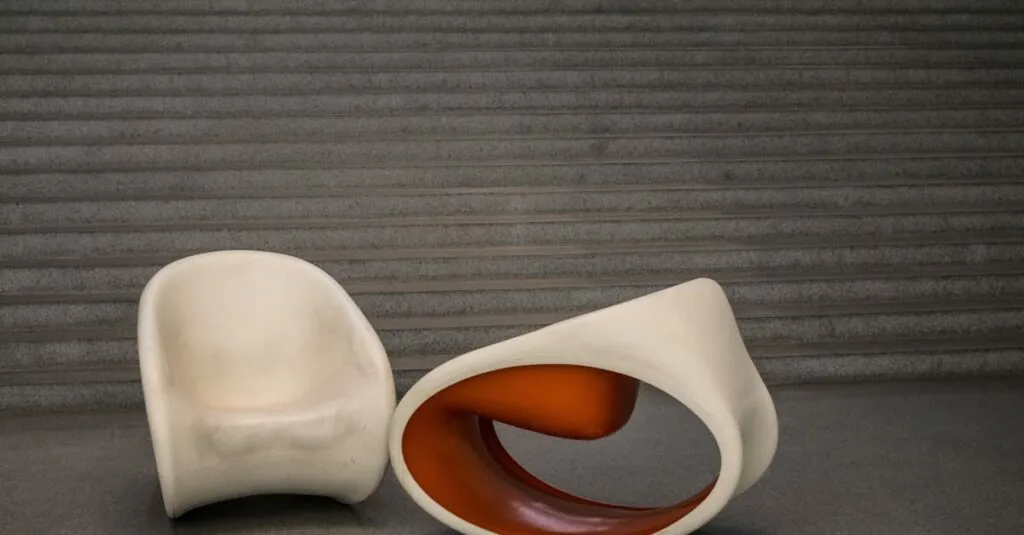In a world overflowing with cookie-cutter designs, finding elegance in uniqueness can feel like searching for a needle in a haystack—blindfolded. Yet, the magic of elegant unique design concepts lies in their ability to transform mundane spaces into extraordinary experiences. Imagine walking into a room that not only catches your eye but also tickles your imagination. That’s the power of innovative design.
From chic interiors that whisper sophistication to quirky elements that spark joy, these concepts redefine what it means to be stylish. They break the mold, proving that elegance doesn’t have to be stuffy or predictable. So, if you’re ready to ditch the ordinary and embrace the extraordinary, dive into the world of design that’s as unique as your personality. Who knew elegance could be so fun?
Table of Contents
ToggleUnderstanding Elegant Unique Design Concepts
Elegant unique design concepts stand out by merging distinct elements with refined aesthetics. These concepts contribute to creating spaces that resonate with individuality and style.
Definition and Characteristics
Elegant unique design concepts embody creativity through distinctive attributes. They often feature clean lines, innovative materials, and bold color palettes, which create a cohesive yet diverse environment. Flexibility in design allows for personalized touches, making each space reflect individual tastes. Characteristic elements include a focus on functionality paired with visual appeal. Additionally, these concepts embrace unexpected combinations, blending traditional styles with modern interpretations. Each combination enhances the overall atmosphere without sacrificing sophistication.
Importance in Design
Importance in design lies in the ability to evoke emotion and spark connection. Unique designs capture attention and create memorable experiences. Such concepts break the mold, offering alternatives to conventional aesthetics and encouraging exploration. Spaces that incorporate these designs often inspire creativity and engagement. Furthermore, they promote a sense of identity, representing personal stories and cultural backgrounds. By choosing elegant unique design concepts, individuals express themselves while elevating their environments, ensuring that spaces remain relevant and inspiring over time.
Examples of Elegant Unique Design Concepts
Elegant unique design concepts manifest in various domains, showcasing creativity and individuality. This section explores how architecture, product design, and fashion embody these distinctive styles.
Architecture
Innovative architecture often blends functionality with striking aesthetics. Curvilinear shapes integrated within urban landscapes influence perceptions of space. Iconic buildings, like the Guggenheim Museum in Bilbao, Spain, exhibit twisting forms that draw attention. Natural materials often complement modern designs, fostering harmony with the environment. Sustainable practices further enhance elegance, emphasizing eco-friendliness. The RIT’s Golisano Institute for Sustainability employs solar power features alongside sleek lines, illustrating the fusion of beauty and purpose.
Product Design
Unique product design emphasizes user experience while prioritizing aesthetic appeal. Brands like Apple exemplify this through minimalist designs that prioritize clean lines and functionality. Designers often experiment with unconventional materials, pushing boundaries in both form and utility. For instance, the Alessi kettle, crafted with stainless steel and a whimsical bird-shaped whistle, marries playfulness with elegance. Ergonomics play a vital role, ensuring products not only look good but feel good in users’ hands. Color schemes also enhance emotional connections, as seen with IKEA’s vibrant yet simple furniture designs.
Fashion
Fashion becomes a canvas for expressing individuality through elegant design concepts. High-end brands like Alexander McQueen push traditional boundaries with avant-garde silhouettes and intricate details. Seasonal collections frequently highlight bold colors and textures, playing with visual contrasts. Designers often merge classic elements with modern influences, appealing to diverse tastes. The use of sustainable fabrics reflects a growing consciousness, making eco-friendly choices fashionable. Accessories like statement jewelry or structured handbags complete outfits, showcasing personal style and elegance.
Trends Influencing Elegant Unique Design Concepts
Elegant unique design concepts evolve continually, shaped by various trends. Two prominent trends include minimalism and sustainability.
Minimalism
Minimalism emphasizes simplicity and functionality. This design philosophy centers on clean lines and uncluttered spaces, fostering a sense of tranquility. Consider the work of designers like John Pawson, whose spaces encapsulate minimalistic elegance through careful consideration of light, texture, and spatial relationships. Key components often include neutral color palettes, which enhance the understated elegance of minimal designs. Architects and interior designers integrate minimalism into residential and commercial spaces, allowing for personalization without overwhelming the senses. By reducing distractions, minimalistic designs highlight essential features, inviting focus on craftsmanship and form.
Sustainability
Sustainability significantly influences contemporary design practices. Designers increasingly prioritize eco-friendly materials and processes, reflecting a growing awareness of environmental impacts. Bamboo flooring, recycled metals, and natural fabrics represent popular sustainable choices in various domains. In architecture, green buildings incorporate renewable energy sources, optimizing both functionality and aesthetics. Designers such as Thomas Heatherwick showcase innovative methods, blending beauty with ecological responsibility. These sustainable practices not only foster elegant designs but also inspire a cultural shift toward conscientious living. Incorporating sustainable elements contributes to a narrative that emphasizes harmony between elegance and environmental stewardship.
The Process of Creating Elegant Unique Design Concepts
Creating elegant unique design concepts involves a structured approach that combines creativity with practicality. Designers start by immersing themselves in inspiration and research, laying the groundwork for innovative ideas.
Inspiration and Research
Inspiration can come from various sources, including nature, art, and cultural elements. Designers often explore historical styles and contemporary trends to gather insights. Researching audience preferences helps in identifying what resonates with potential users. Trends such as biophilic design provide valuable context, emphasizing a connection between indoor and outdoor environments. By analyzing existing designs and user feedback, designers can uncover gaps ripe for innovation.
Sketching and Prototyping
Sketching serves as a powerful tool for visualizing ideas. Designers create rough drafts to explore different layouts and forms, allowing for flexibility in the creative process. Initial sketches evolve into refined concepts, fostering collaborative discussions among teams. Prototyping follows, giving designers a tangible model to test functionality and aesthetics. Mock-ups help refine the user experience, as feedback guides adjustments. Implementing user-centered design principles ensures that the final concept aligns with both elegance and practicality.
Embracing elegant unique design concepts opens the door to a world where creativity meets individuality. By prioritizing personal expression and aesthetic appeal, designers can craft spaces that not only captivate but also resonate deeply with those who inhabit them. The fusion of minimalism and sustainability further enhances this journey, allowing for designs that are both beautiful and environmentally conscious.
As individuals seek to transform their surroundings, they’ll find that unique designs serve as a powerful means of self-expression. The future of design lies in the hands of those willing to explore and innovate, creating environments that reflect their true essence while leaving a lasting impact.





